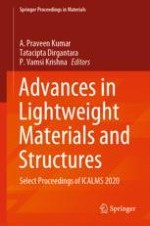This book presents select proceedings of the International Conference on Advanced Lightweight Materials and Structures (ICALMS) 2020, and discusses the triad of processing, structure, and various properties of lightweight materials. It provides a well-balanced insight into materials science and mechanics of both synthetic and natural composites. The book includes topics such as nano composites for lightweight structures, impact and failure of structures, biomechanics and biomedical engineering, nanotechnology and micro-engineering, tool design and manufacture for producing lightweight components, joining techniques for lightweight structures for similar and dissimilar materials, design for manufacturing, reliability and safety, robotics, automation and control, fatigue and fracture mechanics, and friction stir welding in lightweight sandwich structures. The book also discusses latest research in composite materials and their applications in the field of aerospace, construction, wind energy, automotive, electronics and so on. Given the range of topics covered, this book can be a useful resource for beginners, researchers and professionals interested in the wide ranging applications of lightweight structures.
